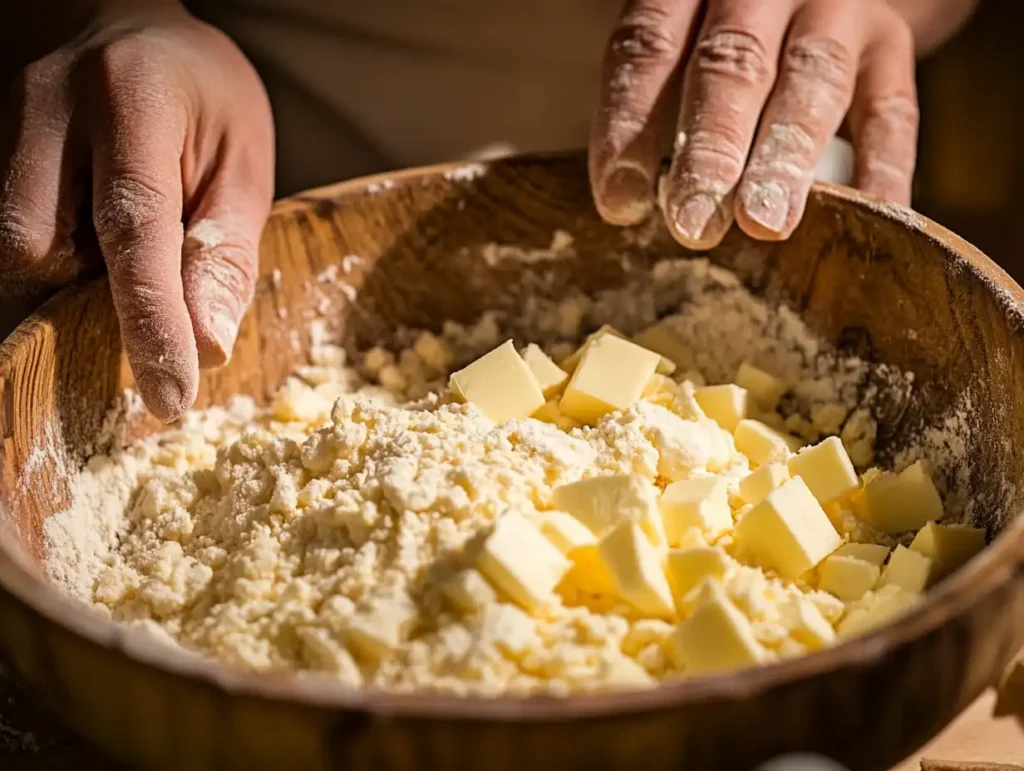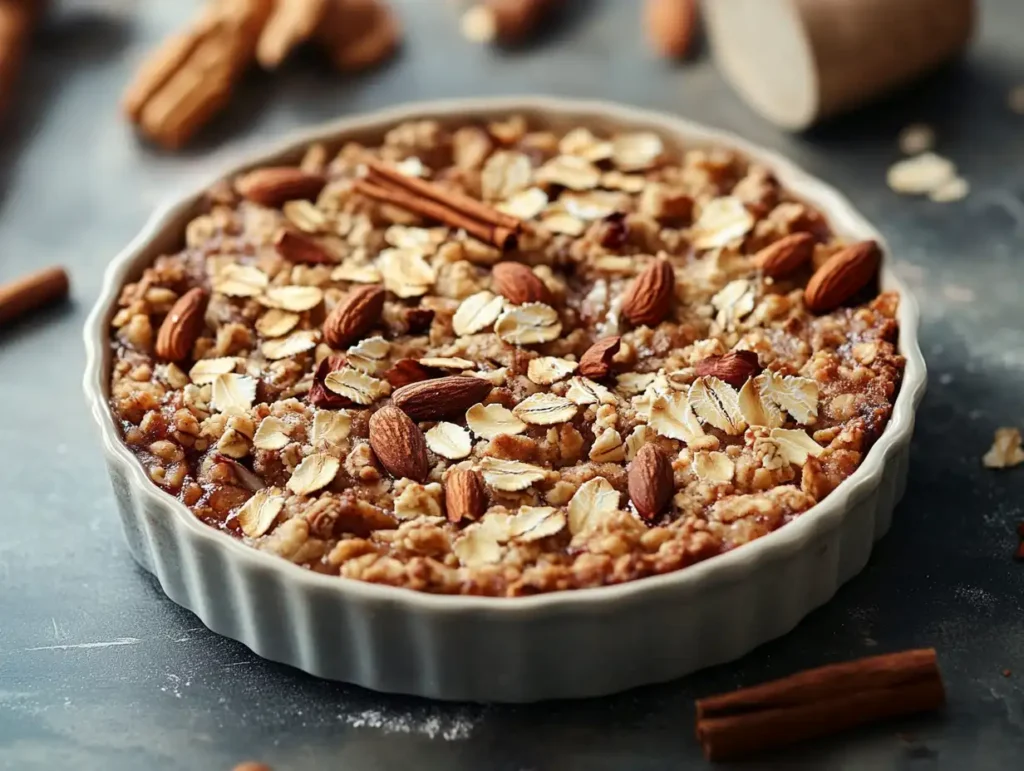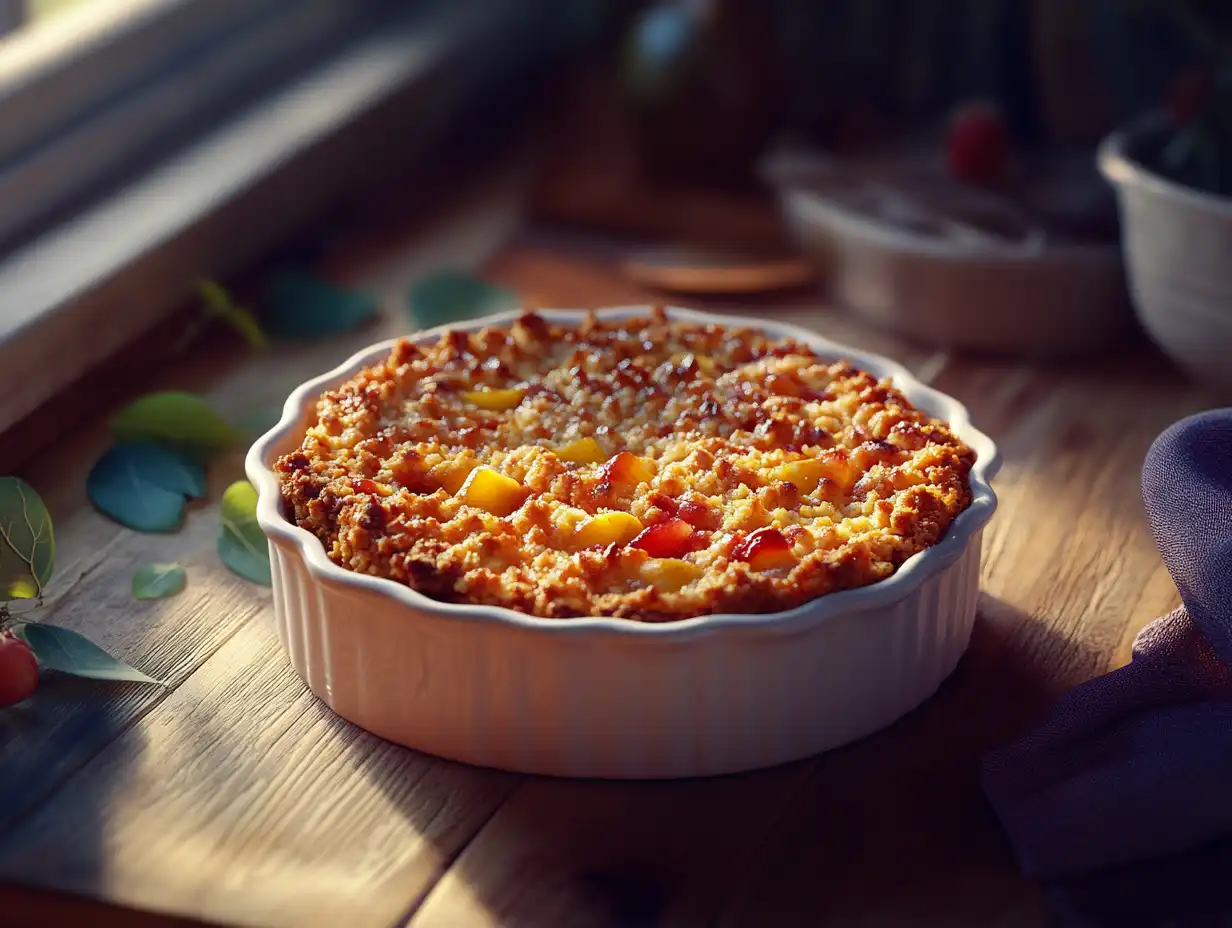What is the secret to good crumble ? The aroma of freshly baked crumble is a universal comfort, invoking memories of family dinners, cozy gatherings, or a simple treat for yourself on a cool evening. A crumble, with its crisp, golden topping and luscious fruit filling, strikes the perfect balance between indulgence and simplicity. But what is the secret to good crumble? Is it the topping’s texture, the choice of fruit, or the baking process? If you’re curious, you might also want to explore the difference between crumble and streusel to understand the unique elements that make each dessert special.
In this article, we’ll uncover the secret to good crumble by exploring how to create a dessert that’s perfectly crispy, delightfully sweet, and undeniably satisfying. Whether you’re a seasoned baker or a beginner, these tips and techniques will elevate your crumble-making game and ensure you can whip up this classic dessert with confidence.
Table of Contents
What is the Secret of Crumble?
Crumble is a classic dessert that has stood the test of time, delighting generations with its simplicity and irresistible taste. Known for its rustic charm, crumble combines a sweet, buttery topping with a warm, fruit-filled base, creating a harmonious blend of textures and flavors. To explore how it differs from other desserts, learn the difference between a peach crumble and a peach crisp.
Defining Secret to good Crumble in Desserts
At its core, crumble is a baked dessert that features a layer of stewed or fresh fruit topped with a crumbly mixture. The topping, which is key to the secret to good crumble, is typically made from flour, sugar, and fat combined to resemble coarse breadcrumbs. Once baked, it transforms into a golden, crunchy layer that perfectly contrasts with the soft and juicy fruit beneath. For advice on preparing fruits, such as whether to peel peaches, this guide on peach cobbler preparation provides helpful insights.
Unlike pies, crumbles don’t have a bottom crust, making them easier and quicker to prepare. This simplicity has cemented crumble as a go-to dessert for home bakers and professionals alike, showcasing how the secret to good crumble lies in its balance of flavors and textures.
Key Ingredients in a Basic Crumble
To create a perfect crumble, you only need a handful of ingredients. If you’re ready to try your hand at a recipe, why not start with this delightful peach crumble recipe, a classic take on this comforting dessert.
- Flour: Forms the base of the crumble topping, offering structure and a tender crumb.
- Sugar: Sweetens the topping and helps it caramelize during baking. Brown sugar is often preferred for its deep, molasses-like flavor.
- Fat (Butter or Margarine): Provides richness and helps create the desired crumbly texture.
- Fruits: The base of the dessert, ranging from sweet apples to tart berries, provides the flavor foundation.
These ingredients are straightforward, but the way they’re combined and the quality of each component can significantly impact the final result.
The Secret to Perfect Crumble Texture
The texture of a crumble topping is one of the most critical elements of the dish. Achieving the perfect balance between a crisp, golden crust and a slightly tender crumb is the hallmark of a great crumble. To refine your technique, consider exploring the difference between crumble and streusel to understand textural variations.

Balancing Crunch and Softness
The magic of crumble lies in its texture a balance between crunch and softness. To achieve this:
- Use Cold Fat: Keeping the butter or margarine cold ensures the crumble maintains its coarse, crumbly structure. If the fat softens too much, the topping can become greasy or overly dense.
- Avoid Overmixing: The ingredients should be gently combined until they resemble coarse breadcrumbs. Overmixing can lead to a doughy topping that lacks crunch.
- Incorporate Texture Enhancers: Adding oats, nuts, or seeds to the topping introduces a delightful crunch and enhances the overall mouthfeel.
The Role of Fat (Butter, Margarine)
The choice of fat significantly impacts the crumble’s texture and flavor.
- Butter: The traditional choice, butter provides a rich, creamy flavor and contributes to the topping’s flaky texture. Use unsalted butter for better control over the seasoning.
- Margarine: A suitable alternative for those seeking a dairy-free option. Margarine can create a similar texture, though its flavor may be less pronounced.
For best results, cut the fat into small cubes and gently rub it into the flour and sugar mixture. This process helps coat the flour and create those desirable “crumbs.”
Choosing the Right Sugar
Sugar does more than just sweeten the topping; it also plays a role in texture and caramelization.
- Brown Sugar: Adds moisture and a rich, molasses-like flavor, perfect for warm, autumnal crumbles.
- White Sugar: Creates a lighter, crisper topping, ideal for summer fruit crumbles.
- A Mix of Both: Combining brown and white sugar allows you to enjoy the best of both worlds depth of flavor and crunch.
Selecting the Ideal Fruits for Crumble
The fruit base is the heart of a crumble, delivering flavor, juiciness, and natural sweetness. Choosing the right fruits and pairing them well can elevate your crumble to gourmet status. This section delves into selecting and preparing fruits to ensure a perfect balance of flavors and textures.
Seasonal Fruits and Flavor Profiles
Using seasonal fruits not only ensures peak flavor but also keeps your crumble fresh and exciting throughout the year.
- Spring: Rhubarb, strawberries, and cherries add a bright, tangy sweetness.
- Summer: Berries like blueberries, raspberries, and blackberries, along with stone fruits like peaches and plums, bring a luscious juiciness.
- Autumn: Apples, pears, and figs offer warm, comforting flavors.
- Winter: Frozen fruits or preserved options like cranberries can keep your crumble repertoire alive even in the colder months.
Balancing Sweet and Tart Fruits
The best crumbles strike a balance between sweet and tart flavors, preventing the dish from becoming overly cloying. Here are a few combinations to try:
- Apples and Blackberries: A classic pairing with a mix of crisp sweetness and tangy zest.
- Peaches and Raspberries: Perfect for summer, blending rich juiciness with a sharp bite.
- Rhubarb and Strawberries: The tartness of rhubarb is beautifully offset by sweet, fragrant strawberries.
Prepping the Fruits
The way you prepare the fruits can make or break the crumble.
- Chopping Evenly: Ensure the fruit pieces are roughly the same size to promote even cooking.
- Thickening Juicy Fruits: For very juicy fruits like berries or stone fruits, toss them with a bit of flour, cornstarch, or ground almonds to prevent the crumble from becoming watery.
- Flavor Enhancers: A sprinkle of cinnamon, nutmeg, or vanilla extract can add depth to the fruit base. A dash of lemon juice can brighten flavors, especially in very sweet fruit combinations.
By thoughtfully choosing and preparing your fruits, you create a strong foundation for the perfect crumble.
Baking Techniques for a Great Crumble
Perfecting your baking technique is crucial for achieving the ideal crumble. The right preparation, oven settings, and layering methods ensure the topping is golden and crisp while the fruit base is tender and flavorful.
Prepping the Ingredients Correctly
Before assembling the crumble, each component needs proper preparation:
- Chill the Topping: Once you’ve mixed the crumble topping, refrigerate it for 15–20 minutes. Cold topping spreads more evenly and bakes into a better texture.
- Prepare the Fruit Base: Mix your fruits with sugar, spices, and any thickening agents in a separate bowl. This ensures the flavors are evenly distributed.
- Use the Right Dish: A shallow, wide baking dish helps the topping cook evenly while allowing the fruit juices to bubble up without overflowing.
Temperature and Baking Time
Getting the temperature and timing just right is critical:
- Optimal Temperature: Bake your crumble at 375°F (190°C). This moderate heat allows the fruit to soften and release its juices while the topping becomes golden and crisp.
- Timing: A typical crumble takes about 35–45 minutes to bake. Check frequently after the 30-minute mark to avoid burning the topping.
If the topping is browning too quickly while the fruit remains undercooked, cover the dish with aluminum foil for the first 20 minutes, then remove it to finish baking.
Layering for Perfect Flavor Distribution
How you assemble your crumble impacts the final dish:
- Start with Fruit: Spread the fruit mixture evenly in the baking dish. Avoid overpacking to ensure even cooking.
- Top with Crumble: Gently scatter the chilled topping over the fruit, ensuring it’s evenly distributed but not pressed down. A loose topping creates a more satisfying crunch.
As the crumble bakes, the fruit juices will bubble up and slightly caramelize, infusing the topping with rich, fruity notes.
Enhancing Your Crumble with Variations
While the classic crumble is always a winner, experimenting with different ingredients and flavor combinations can take your dessert to the next level. This section explores creative ways to enhance the traditional crumble recipe, offering options to suit diverse palates and occasions.
Adding Nuts, Oats, and Spices
Incorporating additional elements into your topping can elevate its texture and flavor profile:

- Nuts: Chopped almonds, walnuts, or pecans introduce a delightful crunch and a rich, nutty flavor.
- Oats: Rolled oats add a rustic charm and chewy texture to the topping. They pair especially well with warm spices and hearty fruits like apples or pears.
- Spices: Cinnamon, nutmeg, cardamom, or allspice can infuse the topping and fruit base with aromatic warmth.
For a holiday twist, consider adding a pinch of ground cloves or ginger to your crumble mixture.
Incorporating Savory Elements
Savory crumbles are an unexpected twist that can impress guests and expand your repertoire.
- Cheese: A sprinkle of grated Parmesan or sharp cheddar in the topping pairs wonderfully with savory ingredients like roasted vegetables or caramelized onions.
- Herbs: Fresh thyme, rosemary, or sage can add depth and complexity, transforming your crumble into a unique main course or appetizer.
Experimenting with savory ingredients lets you enjoy crumble beyond dessert, showcasing its versatility as a dish.
Exploring Gluten-Free and Vegan Options
Adapting crumble recipes for dietary needs is simpler than you might think:
- Gluten-Free: Swap out all-purpose flour for almond flour, oat flour, or a gluten-free baking blend. These alternatives often add new dimensions to the crumble’s flavor and texture.
- Vegan: Replace butter with plant-based alternatives like coconut oil, vegan margarine, or even chilled almond butter for a nutty twist.
With these variations, everyone at the table can enjoy this comforting dish, no matter their dietary preferences.
FAQ
Why is my crumble not crispy?
A lack of crispiness often results from improper preparation or baking. Ensure the fat in the topping is cold and the mixture is not overworked. Also, bake at the right temperature (375°F or 190°C) to allow the topping to caramelize and crisp up.
Can I use frozen fruits?
Yes, frozen fruits work well in crumbles. However, they tend to release more liquid than fresh fruits, so it’s a good idea to toss them with a thickening agent like cornstarch or flour before assembling the dish.
What is the best crumble topping ratio?
A reliable ratio for crumble topping is 2 parts flour, 1 part sugar, and 1 part fat (butter or margarine). Adjust the quantities slightly based on your preferences for sweetness and texture.
How do I make a vegan crumble?
To make a vegan crumble, substitute butter with plant-based alternatives like vegan margarine, coconut oil, or chilled almond butter. Ensure your sugar is vegan-friendly (some brands use bone char in processing).
Can crumble be made ahead of time?
Yes, you can prepare the crumble in advance. Assemble the dish and refrigerate it, unbaked, for up to 24 hours. Bake it fresh when you’re ready to serve. Alternatively, you can bake it, cool it, and reheat it gently before serving.
How do I prevent soggy crumble?
To avoid soggy crumble:
- Toss juicy fruits with a thickening agent before assembling.
- Bake in a shallow dish to allow even cooking and prevent excessive liquid pooling.
- Let the crumble rest for 10–15 minutes after baking to allow the fruit juices to settle.
Conclusion
Creating the perfect crumble is an art that combines simple ingredients, thoughtful preparation, and a touch of creativity. Whether you’re crafting a classic apple crumble or experimenting with exotic fruit and savory variations, understanding the key elements texture, fruit selection, and baking techniques will ensure your crumble is a success every time. The secret to good crumble lies in these foundational aspects.
By balancing the crispiness of the topping with the tenderness of the fruit filling, you create a dessert that is as satisfying to make as it is to eat. Don’t be afraid to experiment with nuts, oats, or spices in the topping or mix and match fruits for unique flavor profiles. And for those with specific dietary needs, adapting the recipe to be vegan or gluten-free is simple and rewarding.
A well-made crumble isn’t just a dessert; it’s a statement of comfort and creativity that brings people together. So, gather your ingredients, preheat your oven, and discover the joy of baking the perfect crumble. With these tips and tricks, the secret to good crumble will no longer be a mystery, and you’re sure to impress with every bite.

